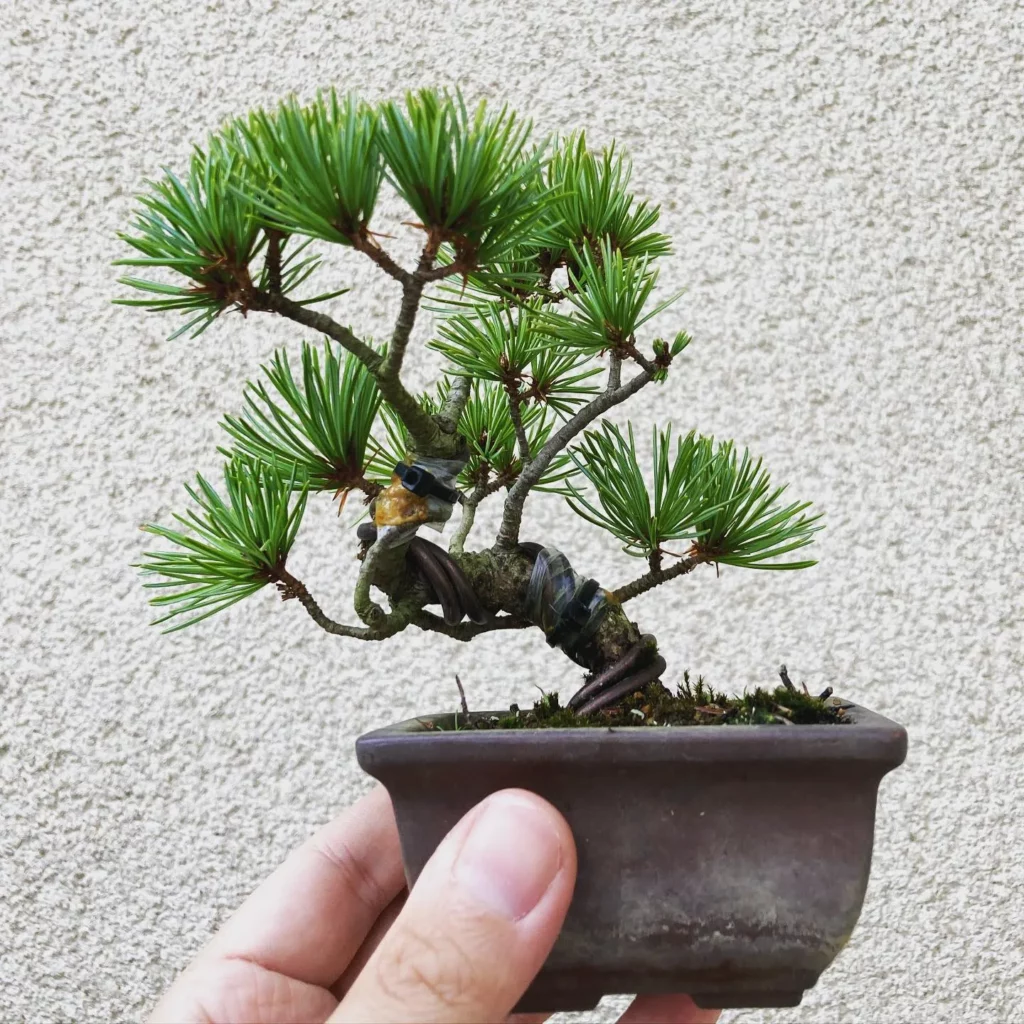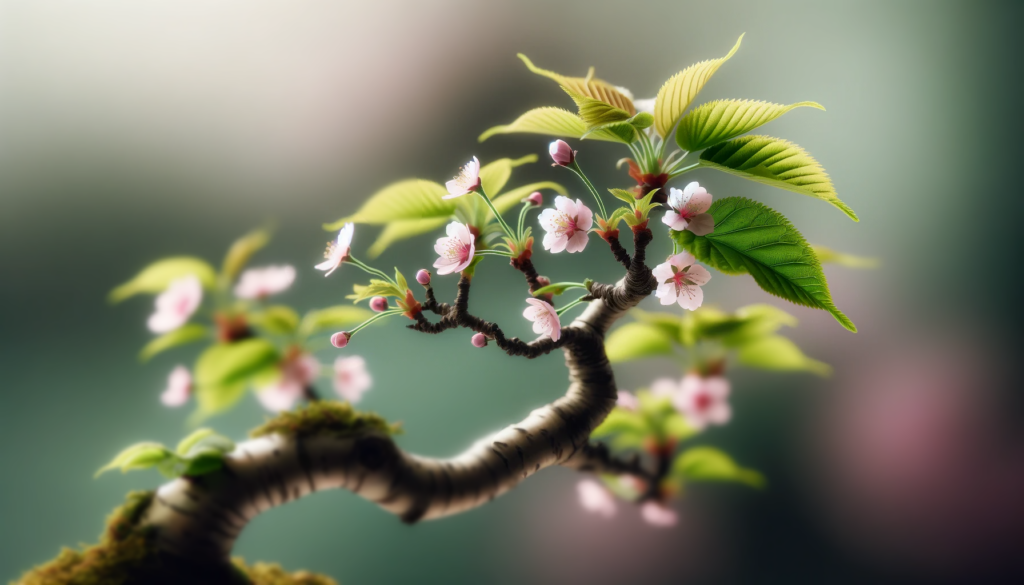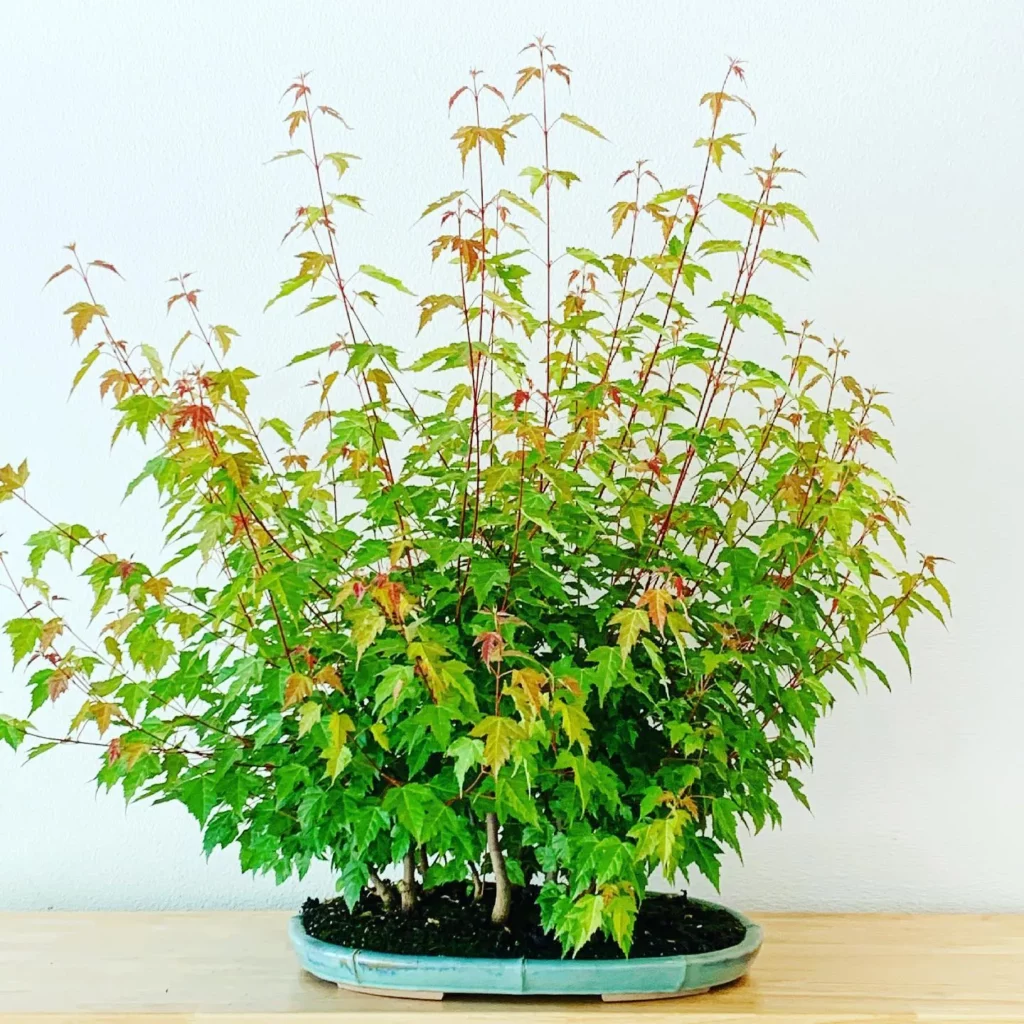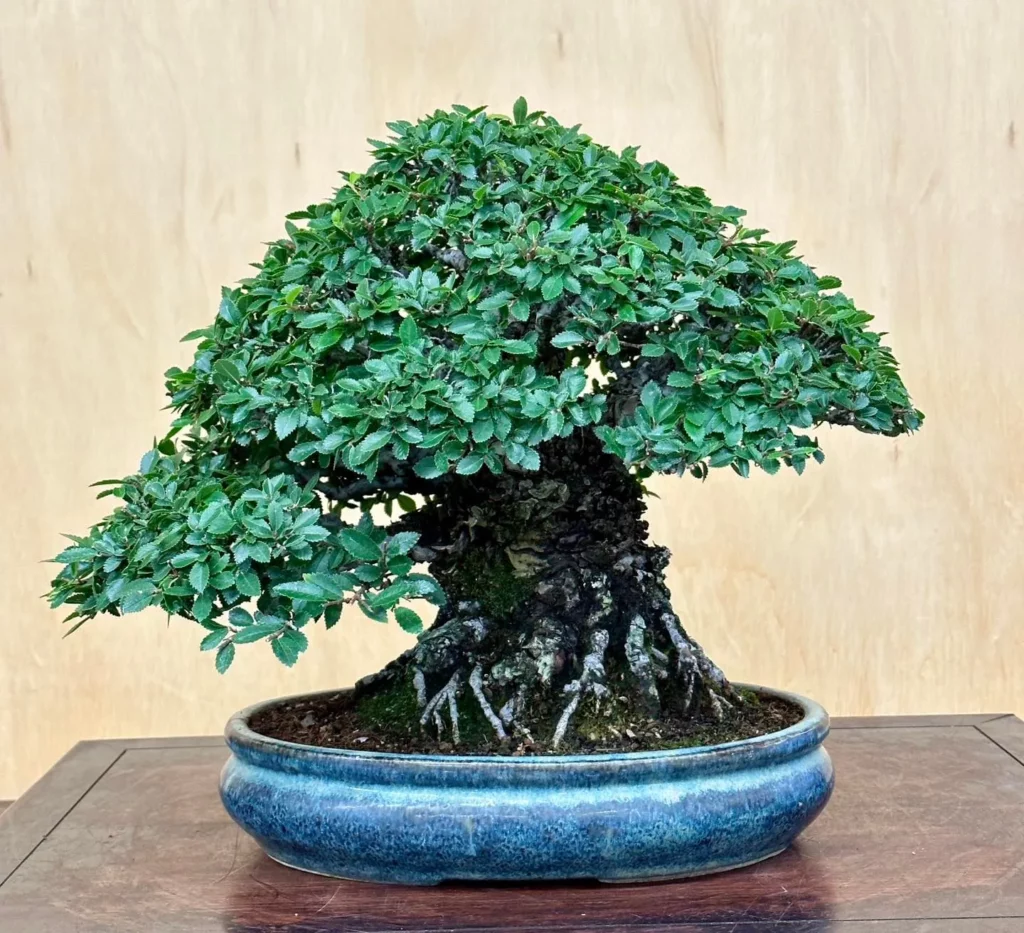Brazilian Rain Tree, scientifically known as Pithecellobium tortum, is native to the lush rainforests of Brazil. With its delicate branches, compound leaves, and fragrant puffy flowers, the Brazilian Rain Tree Bonsai is truly a captivating addition to any bonsai collection.
Appearance of the Brazilian Rain Tree Bonsai



The Brazilian Rain Tree Bonsai is a captivating tree with a distinctive appearance. Its delicate branches are adorned with tiny light-green compound leaves and spines, creating a unique texture.
One remarkable feature of this bonsai is the behavior of its leaves. They fold up in the evening, creating an enchanting display, and open up again in the morning, welcoming a new day. The tree also produces fragrant white or pinkish flowers, adding to its beauty and charm.
No products found.
The Brazilian Rain Tree Bonsai’s appearance is truly captivating, making it a popular choice among bonsai enthusiasts. Its delicate branches, compound leaves, and intriguing leaf-folding behavior make it a fascinating addition to any collection. Whether placed indoors or outdoors, this bonsai variety is sure to capture attention with its distinctive beauty.
| Feature | Description |
|---|---|
| Branches | Delicate and gracefully arching |
| Leaves | Tiny light-green compound leaves with spines |
| Leaf-Folding | Leaves fold up in the evening and open up in the morning |
| Flowers | Fragrant white or pinkish flowers |
Light Requirements for the Brazilian Rain Tree Bonsai



Proper lighting is essential for the health and growth of your Brazilian Rain Tree Bonsai. This rainforest plant thrives in a sunny location outside during the growing season. It enjoys full sun, just like in its natural habitat. However, during the hottest days of tropical summers, providing some shade can prevent the tree from getting stressed.
When temperatures drop below 45°F, it is crucial to bring your bonsai indoors. Placing it near a south-facing window or under grow lights will ensure it receives adequate light. The Brazilian Rain Tree Bonsai needs plenty of light to photosynthesize and grow. Without enough light, the tree may become weak and susceptible to diseases.
Optimizing Light Conditions:
- During the growing season, place your bonsai in a sunny spot outdoors
- Provide shade during the hottest days to prevent stress
- When temperatures drop, bring the bonsai indoors
- Place it near a south-facing window or under grow lights
| Light Conditions | Location | Notes |
|---|---|---|
| Full Sun | Outdoors | Ideal during the growing season |
| Partial Shade | Outdoors | Provide shade on hot days |
| Indirect Bright Light | Indoors | Near a south-facing window or under grow lights |
Watering the Brazilian Rain Tree Bonsai



Proper watering is essential for the health and vitality of your Brazilian Rain Tree Bonsai. The rootball of the bonsai should be kept slightly moist at all times to ensure optimal growth. However, it should never be allowed to dry out completely.
When watering your bonsai, it’s important to use a gentle, fine mist spray or a watering can with a narrow spout to avoid disturbing the delicate branches and leaves. Allow the water to soak the soil thoroughly until it begins to drain out of the drainage holes at the bottom of the pot. Be cautious not to overwater, as this can lead to root rot and other problems.
Tip: To provide additional humidity, especially when the bonsai is kept indoors, you can mist the foliage regularly or place the bonsai on a tray filled with wet gravel. This helps simulate the damp conditions that the Brazilian Rain Tree Bonsai thrives in.
Potting Soils for Brazilian Rain Tree Bonsai
The choice of potting soil is also crucial for maintaining the appropriate moisture levels for your Brazilian Rain Tree Bonsai. A well-draining soil mix is recommended to prevent waterlogging and promote healthy root growth.
Consider using a bonsai-specific soil mix that contains a combination of organic matter, such as bark or peat moss, and inorganic components like perlite or pumice. This combination ensures good drainage while retaining enough moisture for the tree’s needs.
Tip: When repotting your Brazilian Rain Tree Bonsai, gently prune the roots, removing any damaged or excessively long roots. This will help prevent overcrowding in the pot and promote healthier growth.
| Soil Component | Ratio |
|---|---|
| Organic Matter (e.g., Bark or Peat Moss) | 50% |
| Inorganic Component (e.g., Perlite or Pumice) | 50% |
Fertilizing the Brazilian Rain Tree Bonsai
Proper fertilization is essential for the healthy growth and development of the Brazilian Rain Tree Bonsai. By providing the necessary nutrients, you can ensure that your bonsai thrives and maintains its lush foliage and vibrant flowers. Here are some important considerations when it comes to fertilizing your Brazilian Rain Tree Bonsai:
Determining the Right Fertilizer
When choosing a fertilizer for your Brazilian Rain Tree Bonsai, it is important to opt for a balanced liquid fertilizer. Look for a formula that provides a mix of essential macronutrients such as nitrogen (N), phosphorus (P), and potassium (K). These nutrients play a crucial role in supporting overall plant health and promoting vigorous growth.
No products found.
Timing and Frequency
The Brazilian Rain Tree Bonsai requires regular and consistent fertilization during the growing season. It is recommended to fertilize your bonsai weekly, diluting the fertilizer according to the manufacturer’s instructions. This frequent feeding helps provide a steady supply of nutrients to support the bonsai’s growth and maintain its vitality.
During the winter months, when the tree is in a period of dormancy, you can reduce the frequency of fertilization to once a month. This allows the tree to rest and conserve energy while still receiving the necessary nutrients to sustain its health.
Application Techniques
When applying fertilizer to your Brazilian Rain Tree Bonsai, it is essential to follow a few best practices. Start by thoroughly watering the bonsai before fertilizing to avoid any potential root burn. Dilute the liquid fertilizer in water according to the package instructions, ensuring that you do not exceed the recommended dosage. Apply the fertilizer evenly to the soil surface, taking care not to let it come into direct contact with the foliage or trunk of the bonsai.
| Fertilizing Tips for the Brazilian Rain Tree Bonsai |
|---|
| Choose a balanced liquid fertilizer that provides essential macronutrients. |
| Fertilize your bonsai weekly during the growing season. |
| Reduce the frequency of fertilization to once a month during winter dormancy. |
| Thoroughly water the bonsai before applying fertilizer. |
| Apply the diluted fertilizer evenly to the soil surface, avoiding contact with the foliage and trunk. |
Potting the Brazilian Rain Tree Bonsai



Proper potting is essential for the health and development of your Brazilian Rain Tree Bonsai. It is recommended to repot the bonsai every two to three years, as it allows for root pruning and provides fresh soil for optimal growth. Mid-summer is the ideal time for repotting when the tree is in its most resilient state.
When choosing a pot, select one that is slightly larger than the current pot to allow for future root growth. It’s important to use a well-draining soil mix that provides adequate aeration and prevents waterlogged roots. A mixture of akadama, pumice, and lava rock is commonly used for Brazilian Rain Tree Bonsai.
No products found.
To repot, gently remove the bonsai from its current pot, taking care not to damage the delicate roots. Trim any excessive root growth and prune any damaged or unhealthy roots. Place a layer of fresh soil at the bottom of the new pot, position the tree in the center, and carefully fill the pot with the soil mix, ensuring the roots are evenly distributed and covered.
After repotting, water the bonsai thoroughly to help settle the soil and promote root establishment. Place the bonsai in a shaded area for a few weeks to allow it to recover from the repotting process.
Regularly monitor the soil moisture level and water accordingly, ensuring the rootball remains slightly moist but not overly saturated. Remember to adjust your watering schedule based on environmental conditions and the specific needs of your Brazilian Rain Tree Bonsai.
Potting Tips for Brazilian Rain Tree Bonsai
| Tip | Description |
|---|---|
| Repotting Frequency | Every two to three years |
| Optimal Repotting Time | Mid-summer |
| Pot Selection | Slightly larger than the current pot |
| Soil Mix | Akadama, pumice, and lava rock |
| Root Pruning | Trim excessive growth and damaged roots |
| Watering After Repotting | Thoroughly water to settle the soil |
| Recovery Period | Keep in a shaded area for a few weeks |
| Watering Routine | Monitor soil moisture and adjust watering as needed |
Propagation of the Brazilian Rain Tree Bonsai
Propagating the Brazilian Rain Tree Bonsai can be done through various methods such as seeds, cuttings, or air-layering. However, air-layering is considered the most effective method for successful propagation.
To air-layer a branch, start by making a small cut in the bark and then wrap the wounded area with moist sphagnum and peat moss. This creates a favorable environment for the development of new roots. Once the roots have formed, the branch can be carefully removed from the parent tree and potted as a new bonsai.
| Propagation Method | Advantages | Disadvantages |
|---|---|---|
| Seeds | Simple and cost-effective | Takes longer to establish as a bonsai |
| Cuttings | Quicker establishment compared to seeds | May require specialized equipment and techniques |
| Air-layering | High success rate for root development | Requires more time and patience |
When propagating Brazilian Rain Tree Bonsai from seeds, it’s important to note that they have a hard outer shell. To improve germination rates, scarification can be done by gently scratching or nicking the seed coat with sandpaper or a knife. Soaking the seeds in warm water overnight before sowing can also help soften the seed coat and promote germination.
Propagation through cuttings involves taking a section of the tree’s stem or branch and encouraging root growth. The chosen cutting should have at least two nodes and be treated with a rooting hormone before being placed in a well-draining soil mix. Providing bottom heat, high humidity, and regular misting can increase the chances of successful rooting.
Growth and Development of the Brazilian Rain Tree Bonsai



The growth and development of the Brazilian Rain Tree Bonsai is a fascinating journey that requires careful attention and nurturing. When given the right care and environment, this bonsai can reach heights of 2-3 feet and continue to mature for many years. Understanding the growth patterns and techniques for shaping and maintaining the tree will help you create a stunning bonsai specimen.
One key aspect of the Brazilian Rain Tree Bonsai’s growth is its medium growth rate. This means that with proper care, the tree will develop and mature at a steady pace. Regular pruning of shoots and branches is essential to maintain the desired shape and size of the bonsai. Through careful trimming, you can encourage new growth in specific areas and maintain a balanced and aesthetically pleasing appearance.
| Key Points | Details |
|---|---|
| Growth Rate | Medium |
| Pruning and Training | Regular trimming of shoots and branches helps maintain shape and size |
| Visual Appeal | Delicate branches and compound leaves with tiny light-green leaflets |
Pests and Diseases of the Brazilian Rain Tree Bonsai
Proper care and attention can help keep the Brazilian Rain Tree Bonsai healthy and free from pests and diseases. While this bonsai variety is generally resistant, there are a few issues to watch out for.
Nematodes:
Nematodes can cause visible root nodules on the Brazilian Rain Tree Bonsai. If you notice these nodules, it’s important to take action promptly. Treating the infestation with a nematicide can help control the spread of nematodes and protect the health of your bonsai.
Indoor Pests:
When kept as an indoor plant, the Brazilian Rain Tree Bonsai may be vulnerable to aphids, spider mites, and whiteflies. These pests can damage the foliage and sap the vitality of your bonsai. To prevent and manage infestations, specific pesticides designed for indoor use can be applied. Regular inspection of the leaves and stems is important to catch any signs of these pests early on.
Prevention and Maintenance:
Preventing pests and diseases is always better than dealing with an infestation. To minimize the risk, keep your Brazilian Rain Tree Bonsai in optimal health by following the care guide we’ve provided. This includes ensuring proper watering, providing sufficient light, and regular fertilization. Additionally, maintaining good hygiene by cleaning the bonsai’s leaves and regularly inspecting for any signs of trouble can go a long way in keeping pests and diseases at bay.
By staying vigilant and taking proactive measures, you can enjoy a thriving Brazilian Rain Tree Bonsai that remains free from pesky pests and harmful diseases.
FAQ
How often should I water my Brazilian Rain Tree Bonsai?
The rootball of the Brazilian Rain Tree Bonsai should be kept slightly moist at all times. It should never be allowed to dry out completely.
Where should I place my Brazilian Rain Tree Bonsai?
The Brazilian Rain Tree Bonsai prefers a sunny location outside during the growing season. It thrives in full sun but appreciates some shade during the hottest days of tropical summers.
How often should I fertilize my Brazilian Rain Tree Bonsai?
During the growing season, a liquid fertilizer should be applied every week. In winter, fertilization can be reduced to once a month.
How should I repot my Brazilian Rain Tree Bonsai?
The Brazilian Rain Tree Bonsai should be repotted every two to three years with moderate root pruning. It is important to use a well-draining soil mix to prevent root rot. Repotting should be done in mid-summer when the tree is at its least fragile state.
How can I propagate my Brazilian Rain Tree Bonsai?
The Brazilian Rain Tree Bonsai can be propagated from seeds, cuttings, or air-layering. Air-layering is considered the best option for propagation.
How tall can my Brazilian Rain Tree Bonsai grow?
The Brazilian Rain Tree Bonsai can grow up to 2-3 feet in height when properly cared for.
What pests and diseases should I watch out for with my Brazilian Rain Tree Bonsai?
The Brazilian Rain Tree Bonsai is generally resistant to most pests and diseases. However, it can be attacked by nematodes, which cause visible root nodules. When kept indoors, the tree may be susceptible to aphids, spider mites, and whiteflies.




